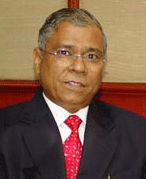

Interview with Mr Om Prakash Lohia

Chairman & MD
Indo Rama Group

Mr Lohia, thanks for opportunity of this exclusive talk one more time. "We are what we repeatedly do. Excellence, then is not an act but a habit," a highly inspiring tenet I must say. Being motivated with such an inspiring leadership, am sure your company would have reposed some more milestones since our previous talk in 2006. Could you please enumerate them?
We had an expansion of our plant which was completed in 2007 with an investment of Rs.1000 crores. The capacity has since been doubled to 6 lakh tonne per annum of polyester fibres and yarns. A recent foray has been into the energy sector and we have an installed cogeneration capacity of 82.5 MW. Immediate plan is to add another 48 MW. Even during the difficult 2008-09 period marked by global recessionary trends, adverse forex movements and highly volatile crude oil prices, the company reported positive operating profits. Currently we are witnessing signs of recovery in the domestic scenario with demand growth in the sector and some macro level stability.
Yes, I remember; our vibrant NEWS team has carried these financial highlights of your group. So, what is your derivation on present state of textiles industry in India and worldwide?
The Indian textile industry is more integrated with the world today than ever before. It is on its way to becoming a major global textiles and apparels sourcing hub with more and more international fashion brands increasing their sourcing from India. Though the recent years till 2007-08 witnessed continuous growth both in domestic and export markets, the global meltdown of 2008 did impact adversely. There are now signs of recovery. However, the industry may be required to wait for some more time for the full recovery and growth to happen.
With industry, we await that fortunate time. Which all chokepoints need to be considered before anticipating this progress of Indian synthetic fibres industry?
There are anomalies in duty structures. Synthetic fibres in spite of being the common man’s fibre is levied 8% excise duty while for cotton it is at 4%.
Customs Duty on the main raw materials for polyesters, Purified Terephthalic Acid (PTA) and Mono Ethylene Glycol (MEG), is zero in neighboring countries like Thailand, Indonesia and Pakistan. Measures should be taken to ensure availability of raw materials and finished products at competitive prices in line with neighboring countries.
Furnace Oil, which is extensively used by manufacturing units to run their DG sets to augment their power requirements, has an excise duty of a staggering 14%. This has a direct bearing on the price of finished goods. Besides, this scenario also generates CENVAT accumulation due to inverted duty structure of 8% on finished goods like fibres and yarns.
While the cost of borrowing for capital expenditures is pretty high, there is no incentive for modernization of manufacturing processes and plants.
In this context, how do you look forward to National Fiber Policy?
The differential discrepancy at 4% in the excise duty structures between cotton and polyester still exists. There ought to be a level playing field between all competing fibres, both natural and synthetic.
In our last talk, commenting on future polyester cycle, you had mentioned about the industry’s shift to China and India to be the two most important sourcing destinations for textiles in the post-quota era. In present context, do these countries remain slated?
Together, these two countries command more than 70% of the global polyester production. With quota restriction dismantled in January 2009 for China and its alignment with WTO, dynamics of inflows and outflows are expected to change. Still, with capacities already in place, India and China are ideally positioned to take advantage of the rebound in textile demand and polyester in turn.
If compared, same situation of bullish price trend in polyester value chain persist a year back in 2008; does this point up further demand downfall in later 2009 and early 2010? If not, what would be determinants preventing this obvious situation then?
Polyester is most economically and favorably placed against fibres like cotton and viscose. The overall cotton production in the current year has reduced as compared to last year and signs are still not encouraging because of unfavorable monsoon. The high cotton prices are hence expected to continue. Viscose prices are also high and have been on the rise. At the same time price of crude oil, of which our main raw materials are derivatives, is stabilizing. With demand for polyester having already picked up in the last few months, we see a stable and comfortable demand situation in the coming quarters.
How is R&D division at Indorama preparing itself to capture nascent and lucrative industry of non-conventional textiles (technical textiles)?
At Indo Rama, we have taken a conscious decision to focus more on our niche areas.
Well on that note , ending this talk here, we wish the best for all your future ventures, Mr Lohia! Thanks for your precious time and comments!
Thanks!
####### Click here to view previous interview with Indorama GroupDISCLAIMER: All views and opinions expressed in this column are solely of the interviewee, and they do not reflect in any way the opinion of Fibre2Fashion.com.